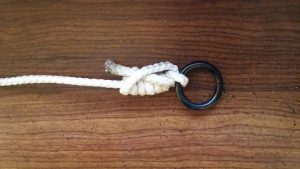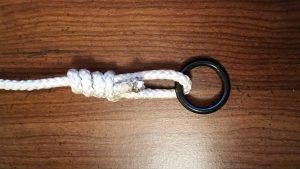When I tie fishing knots for terminal tackle (lures, hooks, etc.), I want them to be strong and simple. There’s no use in trying to tie a knot if you can never remember how to tie it. And you definitely don’t want to tie a knot that slips off or breaks every time you get a fish on the line. You shouldn’t need to know more than two knots for tying on terminal tackle. But to give you some options, I’ve chosen three knots that I believe are the best fishing knots for lures and hooks. They all retain over 80% of the line’s original strength and can be used with both mono-filament and braided line. Here’s how to tie them:
A Classic: The (Improved) Clinch Knot
The clinch knot is the first fishing knot I ever learned to tie. This is also probably the first one you learned to tie and may be the only one you still use. It’s easy to tie, strong, and works great with mono line.
One easy modification will turn the classic clinch knot into the improved clinch knot. I recommend doing this because it takes virtually no more effort than tying the regular clinch knot and it vastly increases the knot’s strength.
To make it easier to see, I used a nylon rope and metal ring:
Best Action: The Non-Slip Mono Loop Knot
If you are using small jigs and other lightweight lures you really can’t go wrong with this loop knot. The non-slip mono loop knot allows the lure’s eye to move freely within the loop. This is different from the clinch knot where the knot is tied tightly to the lure’s eye. This knot is a bit more difficult to tie than the clinch knot, but it’s a knot that’s worth remembering to get the most life-like action out of your jigs and lures.
Another great thing about this knot is that the tag end of the knot faces toward your lure. This means there’s no chance the tag end will snag on weeds or rocks, unlike other knots.
The Strongest: San Diego Jam Knot
If all you care about is just having a really strong knot, the San Diego jam knot is the one for you. This knot is said to retain 94% of the original line strength. What this means is that if you are using 6 lb test line, for example, the line will break when it has around 5.64 lbs of weight on it. This is better than ~85% of the previous two knots, which will break when they have around 5.1 lbs of weight on them. Personally, I’d rather just use heavier line instead of tying a more complex knot. But, to each their own.
Another name for this knot is the reverse clinch knot because it’s almost like tying a clinch knot in reverse. I like this because that means I don’t have to remember how to tie a whole new knot. I just have to remember it’s basically the opposite process of tying the clinch knot.
Knot Tying Tips
- Make sure when wrapping the line around itself that your loops line up nicely and don’t overlap or your knot will lose strength
- Remember to always moisten the knot before tightening to relieve friction. You can use water but I find it easier to use saliva.
- Make sure your knot is completely cinched before you throw your line in the water
- Trim your tag end and leave about ¼” to allow for any unintentional tightening of the knot.
If you are having trouble tying these knots check out animatedknots.com for step by step visuals! Don’t think these are the best fishing knots for lures and hooks? Let us know what you prefer below!